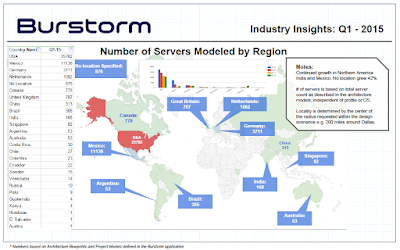Twitter Feed
Virtual Machines in Virtual Networks
One of the key value propositions in cloud computing is built around increase efficiencies. These eficiencies are diven by the use of virtual machines (VMware, XEN, etc.) and the automated…
SOA-R Interest Grows
Interest continue to grow in the use of cloud computing concepts for national security missions. Although some view the idea of a “private cloud” as an oxymoron, I personally see…
Microsoft: “Cloud Computing is the Plan”
From the Wireless Business & Technology Cloud Computing News Desk : “Ballmer highlighted software-plus-service, associating it with a ‘platform in the cloud and delivering applications across PCs, phones, TVs, and…
CC Tidbits
Interesting tidbits from Maureen O’Gara in Apple, Google, Yahoo & Cloud Computing: Industry gadfly John Dvorak is advancing a theory culled from the blogosphere that Microsoft wants Yahoo for some…
Correlative Analytics: Cloud Computing Google Mindshare
Correlative Analytics (A.K.A. “The Google Way of Science“) postulates that extremely large databases of information, starting in the petabyte level, may be sufficient to skip the theory part of the…
What is Cloud Computing? — Another view
Irving Wladasky-Berger, chairman emeritus of IBM’s Academy of Technology, recently wrote and article on cloud computing titled “What is Cloud Computing, Anyway?”. The following is my interpretation of a few…
Dark Cloud Computing
In his blog article “The Rise of The Dark Cloud” Reuven Cohen wonders about a growing interest in covert computing. Although he briefly mentions malevolent uses of the net, the…
July Military Information Technology magazine
This month’s issue of Military Information Technology magazine has the Army’s Chief Information Officer, Lieutenant General Jeffrey A. Sorenson, on the cover. The enclosed special report, titled LANDWARNET Transformation, has…
“The Big Switch” and Intellipedia Highlighted
During last week’s SOA-R session, Steven Armentrout referenced “The Big Switch” by Nicholas Carr as a very enlightened view of our changing world. On July 17th, Information Week’s Richard Martin…
Does anybody really know what cloud computing is?
Less than 2% of the CIOs in an Infoworld survey said that cloud computing was a priority. The surveyed indicated that server virtualization and server consolidation are their No. 1…
as the linking of physical components and boxes together in way that addresses the organization’s needs. With this mindset, they focus on specific technical characteristics and capabilities. While these aspects still remain crucial to a successful deployment, the cloud solution architect must instead, visualize solutions as the linking together of compatible and interoperable services. With this viewpoint, the actual physical components are less of a concern and the service levels and service “-ilities” (maintainability, usability, portability, sustainability, etc.) rise in importance. They also must quantify the business economics of any delivered design. Many times economic aspects alone will define the difference between a new service launch and a new idea left on the shelf.
 |
|
Figure 1– Burnstorm cloud solution modeling software use
|
 |
|
Figure 2– Interactive solution design comparisons
|
( This content is being syndicated through multiple channels. The opinions expressed are solely those of the author and do not represent the views of GovCloud Network, GovCloud Network Partners or any other corporation or organization.)
( Thank you. If you enjoyed this article, get free updates by email or RSS – © Copyright Kevin L. Jackson 2015)
Cloud Computing
- CPUcoin Expands CPU/GPU Power Sharing with Cudo Ventures Enterprise Network Partnership
- CPUcoin Expands CPU/GPU Power Sharing with Cudo Ventures Enterprise Network Partnership
- Route1 Announces Q2 2019 Financial Results
- CPUcoin Expands CPU/GPU Power Sharing with Cudo Ventures Enterprise Network Partnership
- ChannelAdvisor to Present at the D.A. Davidson 18th Annual Technology Conference
Cybersecurity
- Route1 Announces Q2 2019 Financial Results
- FIRST US BANCSHARES, INC. DECLARES CASH DIVIDEND
- Business Continuity Management Planning Solution Market is Expected to Grow ~ US$ 1.6 Bn by the end of 2029 - PMR
- Atos delivers Quantum-Learning-as-a-Service to Xofia to enable artificial intelligence solutions
- New Ares IoT Botnet discovered on Android OS based Set-Top Boxes


